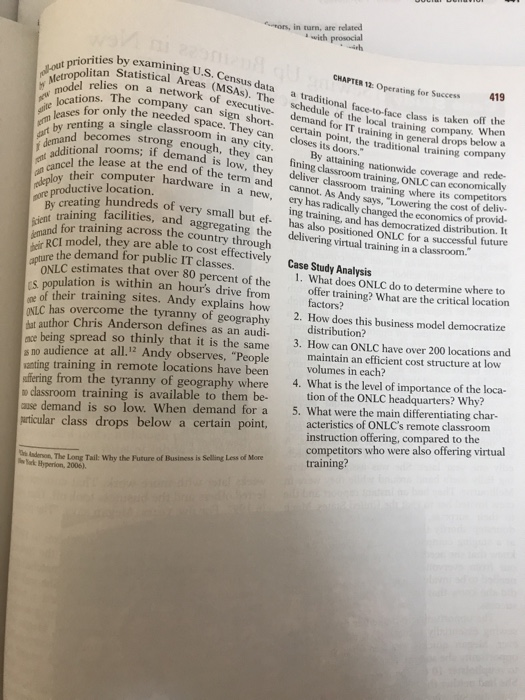Case Study: Virtual IT Training in a Classroom
Answer Case Study Analysis questions 1-5.

Case Study Virtual IT Training in a Classroom ONLC Training Centers has used its many locations to drive significant sales growth and come one of the leaders in the IT training industry. In 2011, ONLC had over 250 locations rom coast to coast but only seven years earlier operated from only three offices. ONLC Training Centers was named the eighth-fastest ing education company on Inc. magazine's st of fastest growing companies in 2009. It achieved remarkable growth in a declining try during the worst economic downturn ONLC was able to realize new revenue streams by rapidly expanding its geographic dis- tribution of classroom training, In 2009, some 50 percent of ONLC's revenues came from sites that had not been open a year earlier. Key driv- ers to their success were the strategic use of loca- tions and the redefinition of classroom trainin Andy Williamson and Jim Palic formed the company in 1983 and they were on the leading edge of the PC revolution when they began offer- ing classroom training through personal comput ers to individuals in the workplace. Throughout the 1980s and 1990s, their facilities were IT Jim Palic and Andy Wiliamson, ONLC classrooms designed for face-to-face instruction. (ONLC Training Centers As corporate training and travel budgets dried up after 2000, demand dropped precipitously and the industry consolidated rapidly Andy and Jim recognized that the demand ing schedule is promoted on the ONLC Web site for training had significantly declined but had For example, if a particular class is running not disappeared. To serve the remaining market January 15, interested individuals can register for public IT training, they needed to transform for it in any one of the 250-plus locations. Eac their business model. They considered offer- of these is a site for two to four people. The se ing virtual training, where people would join sion might be taught in a traditional classroom classes from their homes or offices. However, in Philadelphia, for example, with an instructo ears of experience had taught them that people teaching three students face-to-face. As many as preferred classroom training. A formal class- nine other people could be joining the class from room provides an interruption-free environment up to nine other physical locations around b in which to learn. There are also fewer technical country issues. And going to an off-site location elevates the importance of the hel focus on the job of learning. Instead of abandoning bricks-and-mortar enrollments from hundreds o classroom-based training, they decided to go are able to have fewer classes can deeper into that strategy. They designed a virtual- of low enrollments. Whereas training scenario that keeps the classroom as needed a large number of students in olth part of the solution- '"remote classroom instruc- with an instructor would have hadt tion" (RCI). This provides their clients with a event, ONLC is able to run it with ne udid higher-quality learning environment and gives RCI works like this: A single national train- It is our ability to easily aggregate low event and helps people demand for public training that makes the model successful," says Andy. By combining low ONLC a more defensible position in the market. ONLC management has carefully potential opportunities and identi in turn, are related a with prosocial orities by examining U.S. Census data a traditional face-to-face class is taken of 419 priot statistical Areas (MSAs). The schedule of the local training elow a on a network of executive demand for IT training in general pny CHAPTER 12: Operating for Success modes, The company can sign short certain point, the traditional training taken off the mpany. When ioonly theneeded space. They can closes its doors. ase a single classroom in any city. By attaining nationwide cownomically strong enough, they can fining classroom training, ONLC can ecommptitos tionai a at the end of the term and cannot. As Andy says, "Loweringf provid art by renting single demand becomes stron attaining nationwide coverage and rede- if demand is low, they deliver classroom training where cof ent additional cancel the lease the their comput rooms: ter hardware in a new, ery has radic productive location. cally changed the economics of provid- ing training, and has democratized distribution. It y creating hundreds of very small but ef. ing, and has democratized distribution. has also positioned ONLC for a successful future aggregating the delivering virtual training in a classroom. for training across the country through RCI model, they are able to cost effectively c the demand for public IT classes. aptu Case Study Analysis ONLC estimates that over 80 percent of the 1. What does ONLC do to determine where to s population is within an hour's drive from ne of their training sites. Andy explains how offer training? What are the critical location factors? 2. How does this business model democratize distribution? overcome the tyranny of geography ONLC has at author Chris Anderson defines as an audi. ance being spread so thinly that it is the same 3. How can ONLC have over 200 locations and no audience at all.12 Andy observes, "People maintain an efficient cost structure at low anting training in remote locations have been from the tyranny of geography where 4. What is the level of importance of the loca- o classroom training is available to them be- ase demand is so low. When demand for a 5. What were the main differentiating char- uricular class drops below a certain point, volumes in each? tion of the ONLC headquarters? Why? acteristics of ONLC's remote classroom instruction offering, compared to the competitors who were also offering virtual training? dri lndenon, The Long Tail: Why the Future of Business is Selling Less of More k Hyperion, 2006). Case Study Virtual IT Training in a Classroom ONLC Training Centers has used its many locations to drive significant sales growth and come one of the leaders in the IT training industry. In 2011, ONLC had over 250 locations rom coast to coast but only seven years earlier operated from only three offices. ONLC Training Centers was named the eighth-fastest ing education company on Inc. magazine's st of fastest growing companies in 2009. It achieved remarkable growth in a declining try during the worst economic downturn ONLC was able to realize new revenue streams by rapidly expanding its geographic dis- tribution of classroom training, In 2009, some 50 percent of ONLC's revenues came from sites that had not been open a year earlier. Key driv- ers to their success were the strategic use of loca- tions and the redefinition of classroom trainin Andy Williamson and Jim Palic formed the company in 1983 and they were on the leading edge of the PC revolution when they began offer- ing classroom training through personal comput ers to individuals in the workplace. Throughout the 1980s and 1990s, their facilities were IT Jim Palic and Andy Wiliamson, ONLC classrooms designed for face-to-face instruction. (ONLC Training Centers As corporate training and travel budgets dried up after 2000, demand dropped precipitously and the industry consolidated rapidly Andy and Jim recognized that the demand ing schedule is promoted on the ONLC Web site for training had significantly declined but had For example, if a particular class is running not disappeared. To serve the remaining market January 15, interested individuals can register for public IT training, they needed to transform for it in any one of the 250-plus locations. Eac their business model. They considered offer- of these is a site for two to four people. The se ing virtual training, where people would join sion might be taught in a traditional classroom classes from their homes or offices. However, in Philadelphia, for example, with an instructo ears of experience had taught them that people teaching three students face-to-face. As many as preferred classroom training. A formal class- nine other people could be joining the class from room provides an interruption-free environment up to nine other physical locations around b in which to learn. There are also fewer technical country issues. And going to an off-site location elevates the importance of the hel focus on the job of learning. Instead of abandoning bricks-and-mortar enrollments from hundreds o classroom-based training, they decided to go are able to have fewer classes can deeper into that strategy. They designed a virtual- of low enrollments. Whereas training scenario that keeps the classroom as needed a large number of students in olth part of the solution- '"remote classroom instruc- with an instructor would have hadt tion" (RCI). This provides their clients with a event, ONLC is able to run it with ne udid higher-quality learning environment and gives RCI works like this: A single national train- It is our ability to easily aggregate low event and helps people demand for public training that makes the model successful," says Andy. By combining low ONLC a more defensible position in the market. ONLC management has carefully potential opportunities and identi in turn, are related a with prosocial orities by examining U.S. Census data a traditional face-to-face class is taken of 419 priot statistical Areas (MSAs). The schedule of the local training elow a on a network of executive demand for IT training in general pny CHAPTER 12: Operating for Success modes, The company can sign short certain point, the traditional training taken off the mpany. When ioonly theneeded space. They can closes its doors. ase a single classroom in any city. By attaining nationwide cownomically strong enough, they can fining classroom training, ONLC can ecommptitos tionai a at the end of the term and cannot. As Andy says, "Loweringf provid art by renting single demand becomes stron attaining nationwide coverage and rede- if demand is low, they deliver classroom training where cof ent additional cancel the lease the their comput rooms: ter hardware in a new, ery has radic productive location. cally changed the economics of provid- ing training, and has democratized distribution. It y creating hundreds of very small but ef. ing, and has democratized distribution. has also positioned ONLC for a successful future aggregating the delivering virtual training in a classroom. for training across the country through RCI model, they are able to cost effectively c the demand for public IT classes. aptu Case Study Analysis ONLC estimates that over 80 percent of the 1. What does ONLC do to determine where to s population is within an hour's drive from ne of their training sites. Andy explains how offer training? What are the critical location factors? 2. How does this business model democratize distribution? overcome the tyranny of geography ONLC has at author Chris Anderson defines as an audi. ance being spread so thinly that it is the same 3. How can ONLC have over 200 locations and no audience at all.12 Andy observes, "People maintain an efficient cost structure at low anting training in remote locations have been from the tyranny of geography where 4. What is the level of importance of the loca- o classroom training is available to them be- ase demand is so low. When demand for a 5. What were the main differentiating char- uricular class drops below a certain point, volumes in each? tion of the ONLC headquarters? Why? acteristics of ONLC's remote classroom instruction offering, compared to the competitors who were also offering virtual training? dri lndenon, The Long Tail: Why the Future of Business is Selling Less of More k Hyperion, 2006)









